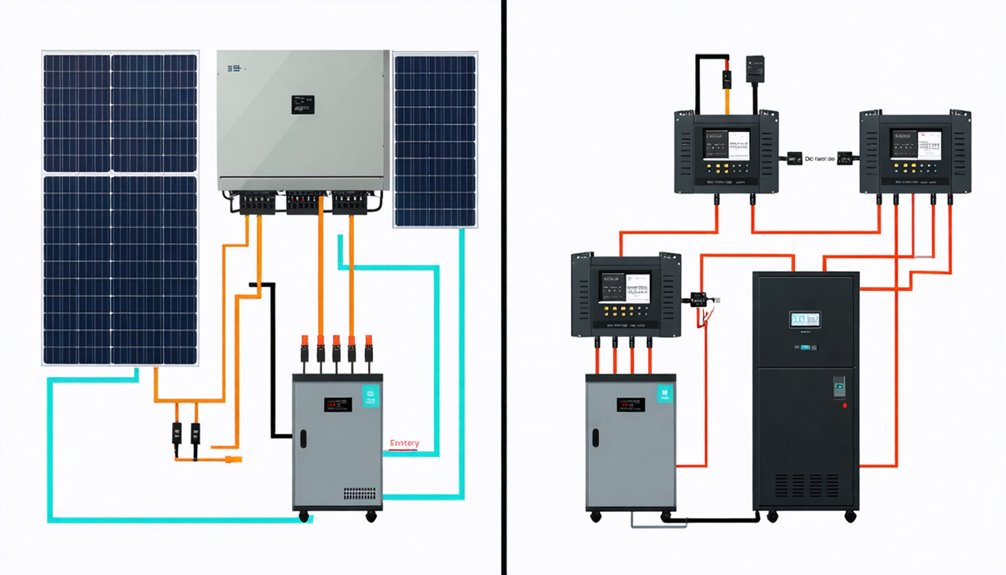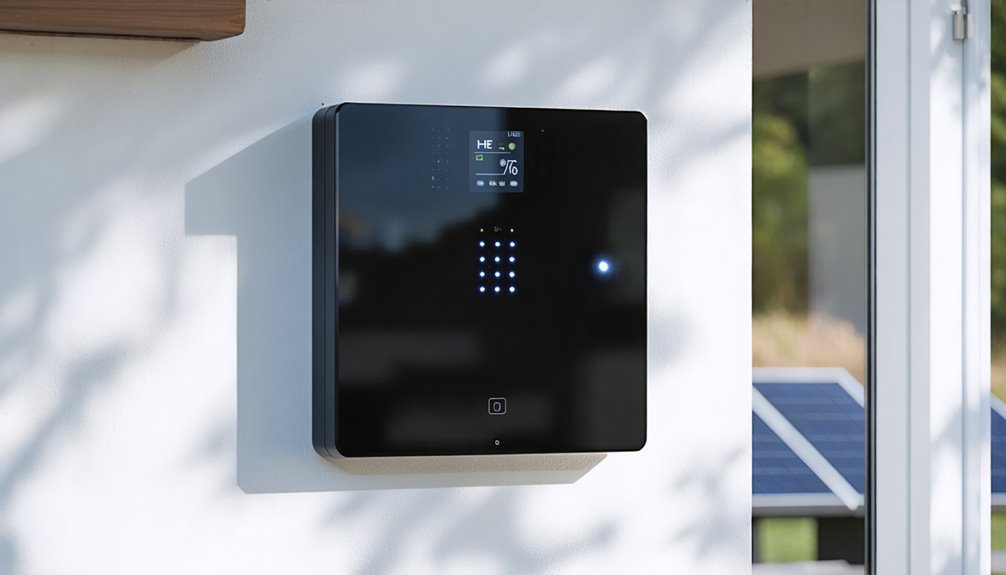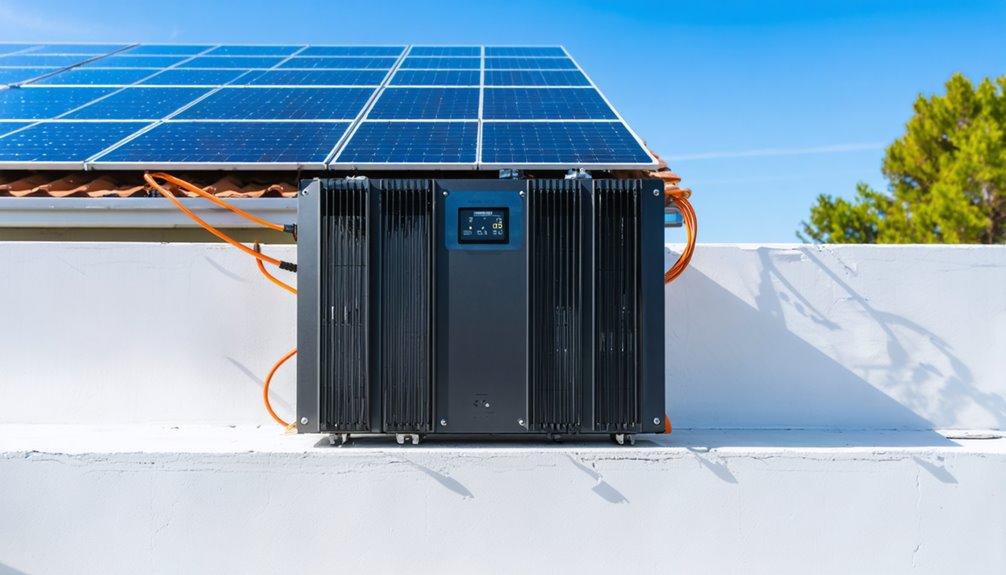You’ve probably seen solar panels on rooftops, but there’s a hidden technology that’s changing how homeowners use solar power. Solar battery storage captures extra electricity your panels generate during sunny days and saves it for later. This means you can use solar energy even when the sun isn’t shining. But how do these batteries actually trap sunlight and turn it into nighttime power?
Understanding Solar Battery Storage Basics
Solar battery storage represents a significant shift in how homes can manage electricity. You’re seeing more households adopt this technology to store excess electricity from their solar panels. These systems work by capturing extra power your panels generate during sunny days. You can then use this stored energy at night or during outages. Most solar battery storage uses lithium-ion technology. It’s the same type found in electric cars and phones. These batteries convert chemical energy into electrical energy through internal reactions. This process lets you achieve energy independence by reducing grid reliance. When you need backup power, these batteries automatically supply your home. Larger systems can power your house for days, while smaller ones handle essential appliances for hours. The upfront price of solar battery systems varies between $5,000 and $15,000 depending on capacity and brand, influencing the decision of homeowners looking to invest in energy storage solutions.
Types of Solar Battery Technologies
Battery technology varies widely when you’re looking at solar storage options. Lithium-ion battery technology dominates the market. These battery systems can last 15 to 30 years and convert energy efficiently.
Two main types exist in solar battery system designs. Lithium Iron Phosphate (LFP) batteries offer better thermal stability. Lithium Nickel Manganese Cobalt (NMC) batteries provide different performance benefits.
Lead-acid batteries cost less but don’t last as long. They can’t discharge as deeply as lithium-ion options. This makes them less popular for renewable energy storage.
Large-scale energy storage solutions include compressed air systems and molten salt thermal storage. These technologies work with big renewable energy projects. Each type serves different needs in the growing solar storage market. Homeowners should consider factors such as battery chemistry differences, including depth of discharge ratings, to select the best solar battery for their energy storage needs.
How Solar Batteries Store Energy
When your solar panels generate electricity, the battery stores it through a chemical process that converts electrical energy into chemical energy. Inside lithium-ion batteries, lithium ions move between two parts called the anode and cathode, creating an electrical current that can be stored and released. This movement happens billions of times as the battery charges and discharges, letting you use solar power even when the sun isn’t shining. Battery management systems play a crucial role in optimizing charging cycles and extending battery lifespan, ensuring efficient energy storage and release.
Chemical Energy Conversion Process
After sunlight hits your solar panels, the energy doesn’t just disappear when it’s not immediately used—it transforms into chemical energy inside lithium-ion batteries. Your battery stores this energy through a fascinating process. When charging, lithium ions move from the cathode to the anode. This movement creates chemical energy that’s stored until you need it.
When your home needs power, the battery discharges power by reversing this process. The lithium ions flow back from the anode to the cathode. At the same time, electrons travel through an external circuit from the negative to positive terminal. This creates the electrical current that powers your lights and appliances. Solar power storage works like a rechargeable battery in your phone, just on a much larger scale to store energy for your entire home.
Lithium Ion Movement Mechanics
Inside your solar battery’s cells, billions of tiny lithium ions create a powerful energy storage system. When you’re charging, these lithium ions flow from one side to the other through a chemical reaction. They travel from the cathode to the anode, where they’ll wait until you need power.
Your battery cells work like tiny warehouses for solar electricity. During discharge, the stored energy releases as lithium ions move back to the cathode. This movement creates an electric current that powers your home.
Energy storage systems rely on this back-and-forth dance of ions. The chemical reaction reverses depending on whether you’re storing or using power. It’s how your battery transforms sunshine into electricity you can use at night.
The Charging Process Explained
When sunlight hits your solar panels, they convert that light into DC electricity that flows directly to your batteries. Inside the battery, chemical reactions store this electrical energy by moving lithium ions between different materials. Your battery management system monitors these reactions to make sure the charging happens safely and doesn’t damage the battery’s components. Additionally, a charge controller is vital in the solar charging process as it prevents overcharging and regulates the voltage and current flowing from the solar panels to the batteries.
Solar Panel Energy Conversion
Solar panels work like tiny power plants on your roof, turning sunlight into electricity through something called the photovoltaic effect. When sunlight hits your solar panel system, it creates DC electricity right away. This direct current flows straight to your battery storage systems during the charging process.
The photovoltaic effect happens when light particles knock electrons loose in the panel’s cells. These moving electrons create the DC electricity that charges your batteries. Your panels don’t need to convert the power since batteries already use DC. This means the stored energy goes directly into your battery without extra steps.
Each panel in your system adds more charging power. Together, they’ll fill your batteries faster on sunny days.
Battery Chemical Reactions
As your battery stores power from solar panels, tiny lithium ions move inside like workers carrying energy packages. During the charging process, these ions travel from the cathode to the anode. Meanwhile, electrons flow through an external circuit from positive to negative terminals. This movement creates chemical potential – stored energy waiting to be used.
When you need power, the discharge begins. The battery chemical reactions reverse direction. Lithium ions rush back to the cathode, and electrons flow the opposite way. This converts the stored chemical energy back into electrical energy that powers your home.
Lithium-ion technology makes this possible through precise chemical reactions. Battery makers use different materials like NMC or LFP cells. Each type affects how much energy you can store and how long your battery lasts.
The Discharging Process and Energy Release
After your battery stores energy from solar panels, it’s ready to power your home through a process called discharging. During the discharging process, your solar battery releases stored energy as electricity flows from the battery to your appliances. Lithium ions move from the anode to the cathode, creating an electric current. Solar batteries, like those used in street lighting systems, typically have a lifespan of 3-7 years due to constant cycling and outdoor exposure.
| System Type | Inversions Needed | Efficiency Impact |
|---|---|---|
| DC-coupled | 1 | Higher |
| AC-coupled | Multiple | Lower |
Your battery’s capacity determines how long it’ll supply power during discharge. Larger energy storage systems provide electricity for extended periods. In grid-tied setups, you can even send excess stored energy back to the grid. This feature lets you earn credits through net metering programs. Your system manages discharge automatically during power outages or when solar generation drops.
Dc-Coupled Vs Ac-Coupled Storage Systems

When you’re choosing a solar battery system, you’ll encounter two main options: DC-coupled and AC-coupled storage. DC-coupled systems connect solar panels directly to batteries, which means batteries charge straight from the photovoltaic energy without extra conversions. These systems achieve about 90% energy efficiency or higher. AC-coupled systems work differently by converting DC electricity from solar panels into AC power for your home and then back to DC for solar energy storage. These multiple conversions reduce overall efficiency. DC-coupled systems work best for new installations because of their streamlined design and lower costs. AC-coupled systems are better for adding batteries to existing solar setups. Both types let you store solar power, but DC systems typically waste less energy during the charging process. Additionally, off-grid locations benefit significantly from the energy independence provided by solar battery systems, ensuring continuous power in areas lacking access to traditional electric grids.
Components of a Solar Battery System
Both DC and AC-coupled systems rely on several key parts to store and deliver solar power. Your energy storage systems start with battery modules that use Lithium Iron Phosphate cells. These cells store electricity safely and last for years.
The Battery Management System (BMS) acts like a guard. It watches your batteries’ health and stops problems before they happen. Meanwhile, the Power Conversion System (PCS) changes stored DC power into AC power that your home can use.
Your batteries sit in weatherproof boxes that won’t catch fire. These boxes have thermal management systems that keep temperatures just right. Finally, Supervisory Control and Data Acquisition (SCADA) systems track everything in real-time. They make sure your solar battery works efficiently every day.
Integration With Solar Panel Systems
You’ll need to connect your solar panels to batteries through either AC-coupled or DC-coupled systems. Your inverter plays a key role by converting the battery’s stored DC electricity into AC power that your home appliances can use. The entire system manages energy flow between your panels, batteries, and home, automatically switching between solar power, stored energy, and grid electricity as needed. Some systems, particularly those using hybrid inverters, can seamlessly switch between grid, solar, and battery sources to maximize energy usage and provide backup capabilities.
Panel to Battery Connection
If you’re looking at solar battery systems, the connection between panels and batteries happens through two main methods. DC coupling lets panels charge batteries directly with DC electricity. This method’s more efficient because it doesn’t need multiple conversions. AC coupling converts the panels’ DC power to AC first, then back to DC for storage. That means more energy loss.
Your solar battery backup needs an inverter to change stored energy from DC to AC for home use. Energy storage systems with hybrid inverters can handle both panels and batteries at once. They’re flexible and let you add more storage later. When panels make excess energy during sunny hours, it goes straight to your batteries. You’ll have power ready for nighttime or cloudy days.
Inverter System Requirements
Three main inverter types handle the connection between solar panels and batteries in today’s systems. Your inverter system converts DC current from panels into AC electricity for home use. It also manages energy stored in batteries.
| Inverter Type | Function | Efficiency |
|---|---|---|
| String Inverter | Converts DC to AC for multiple panels | 95-98% |
| Hybrid Inverter | Manages solar and battery power | 94-97% |
| Microinverter | Converts power at each panel | 96-97% |
| Power Optimizer | Maximizes individual panel output | 98-99% |
| Battery Inverter | Handles battery discharge only | 95-98% |
Hybrid inverters work with battery management systems to monitor battery health. They’re designed to match your solar panel output and storage capacity. DC-coupled systems reduce energy losses since they require fewer conversions than AC-coupled ones.
Energy Flow Management
Energy flows through your solar battery system in a continuous cycle that starts when sunlight hits your panels. Your panels generate direct current (DC) electricity that charges your batteries. When you need power, an inverter converts the DC into alternating current (AC) for your home’s use.
Battery management systems (BMS) monitor this entire process. They’re checking voltage, temperature, and current levels constantly. The BMS guarantees your batteries charge and discharge safely while maximizing their lifespan.
Energy flow management in solar battery storage systems lets you use power strategically. You’re self-consuming stored energy during expensive peak hours instead of buying from the grid. DC-coupled systems connect panels directly to batteries, reducing conversion losses. AC-coupled systems require more conversions, which can decrease efficiency.
Battery Capacity and Depth of Discharge

When you’re considering solar battery storage, you’ll need to understand two key numbers: battery capacity and depth of discharge. Battery capacity measures how much energy your solar battery stores, typically in kilowatt-hours (kWh). This number determines your backup times during outages.
Depth of discharge (DoD) shows what percentage of the battery you can safely use. Most lithium-ion batteries offer 80-90% DoD. You shouldn’t drain the entire battery to protect it from damage.
A 10 kWh battery can power essential systems for about three days, depending on your home’s energy use. Your energy storage needs depend on both numbers working together. Lithium-ion batteries typically last 5-15 years, but their capacity decreases over time. To accurately determine your kilowatt-hour requirements, assessing your home’s energy needs through utility bill examination is recommended.
Solar Battery Efficiency and Energy Loss
You’ll lose some energy every time your solar battery charges and discharges, with modern lithium-ion batteries keeping about 90% to 95% of the power they store. Several factors affect how much energy gets lost, including the type of system you have, how deeply you drain the battery, and the temperature where it’s installed. Understanding these efficiency rates and loss factors can help you know what to expect from your battery’s performance and how to get the most from your stored solar power. Additionally, the battery chemistry you choose, such as lithium-ion versus lead-acid, can significantly influence both the efficiency and cost of your solar battery system.
Conversion Efficiency Rates
A solar panel on your roof captures sunlight, but the journey to stored electricity isn’t perfect. Your battery energy storage systems typically achieve conversion efficiency rates between 80% and 95%. This means you’ll experience some energy loss during the process.
DC-coupled systems perform better than AC-coupled systems. When you’re using DC-coupled technology, your solar panels charge batteries directly. This creates fewer conversion steps and higher efficiency. AC-coupled systems need to convert DC to AC, then back to DC for storage. You can lose up to 15% of energy with these multiple transformations.
Battery management systems help reduce these losses. They monitor and control how energy flows through your system. These smart controllers work constantly to minimize waste and boost your system’s overall performance.
Energy Loss Factors
Several factors contribute to energy loss in your solar battery system beyond the basic conversion process. Temperature variations affect how well your battery works. Extreme heat or cold reduces performance and shortens battery life.
The charging and discharging process also creates losses. DC-coupled systems lose less energy because they need fewer conversions. AC-coupled systems lose more energy through multiple conversions.
Lithium-ion batteries show round-trip efficiency between 80% and 95%. This means you’ll lose 5-20% of stored energy when converting it back to electricity.
Depth of discharge matters too. Lithium-ion batteries let you use up to 90% of their capacity. Lead-acid batteries have lower limits. This affects how much usable energy you’ll get from your system.
Maximizing Storage Performance
Getting the best performance from your solar battery means choosing the right setup and components. DC-coupled systems work better than AC setups. They don’t lose as much energy during conversion.
Energy storage systems face charging losses of 10-20%. That means you’ll lose some power when filling up solar batteries. The type of inverter you pick affects system efficiency too.
Depth of discharge matters for performance. Lithium-ion batteries let you use 80-90% of their stored energy. This gives you more usable power without hurting battery life.
AC-coupled systems can waste up to 30% of energy. They need multiple conversions between DC and AC power. Temperature and battery age also impact how well your system works.
Backup Power During Grid Outages
Power outages can strike without warning, but solar battery storage systems keep the lights on when the grid goes down. Your solar battery systems store energy from solar panels during normal operation. When grid outages occur, they’ll automatically switch to backup power mode.
Unlike fossil fuel generators, these systems run quietly using renewable energy. A 10 kWh battery can power essential devices for three days or more. You’ll maintain electricity for critical systems like refrigerators, medical equipment, and communications.
Energy resilience depends on proper planning. You need to guarantee batteries stay fully charged, especially when storms approach. Solar battery systems eliminate the need for fuel storage and produce no emissions during operation. They’re providing homeowners with reliable, clean backup power solutions. Considering factors like battery chemistry types is crucial when selecting a solar battery that fits your needs and ensures long-term efficiency.
Economic Benefits and Cost Savings

Three key ways solar battery storage cuts energy costs are changing how homeowners think about electricity bills. First, you’ll use stored solar energy at night instead of buying grid power. This creates major cost savings on monthly bills.
Second, solar battery systems help you dodge peak demand charges. When electricity prices spike during busy times, you’ll tap into your stored power. That’s when the economic benefits really show.
Third, these energy-efficient systems boost your home’s value. Future buyers want properties that slash energy bills. Experts say battery storage could save the UK £40 billion by 2050.
You might qualify for rebates that reduce upfront costs. Many homeowners see returns on their investment faster than expected. These systems are reshaping how people power their homes.
Environmental Impact and Carbon Reduction
While saving money matters, solar battery storage‘s biggest impact might be on the planet. These energy storage systems help you use more renewable energy and rely less on fossil fuels. When you store extra solar power during the day, you’ll use it at night instead of drawing electricity from coal or gas plants.
This switch makes a real difference. You’re cutting greenhouse gas emissions every time you use stored solar energy. In areas that depend heavily on fossil fuel electricity, the carbon footprint reduction becomes even bigger. The UK’s energy system could save £40 billion by 2050 through solar battery adoption. That’s not just money saved it’s tons of carbon kept out of the atmosphere. Your stored solar power helps stabilize the grid while fighting climate change.
Maintenance and Lifespan Considerations
Your solar battery won’t last forever, but it’ll give you years of reliable service. Most solar batteries last 5 to 15 years. The lifespan depends on how you use them and where they’re installed.
| Factor | Impact | Typical Range |
|---|---|---|
| Depth of Discharge (DoD) | Higher DoD reduces lifespan | 80-90% ideal |
| Temperature | Extreme heat or cold damages batteries | 50-85°F ideal |
| Charge Cycles | More cycles mean shorter life | 3,000-6,000 cycles |
Battery management systems (BMS) help protect your investment. They monitor charging and discharging cycles to prevent damage. Regular maintenance includes checking connections and updating software.
Manufacturers typically offer 5 to 10-year warranties. They guarantee the battery will maintain a certain performance level during this time.
Conclusion
You’ve learned that solar battery storage captures extra electricity from solar panels for later use. You’ve discovered how lithium-ion batteries convert and store this energy through chemical reactions. You’ve seen how these systems provide backup power during outages while cutting electricity costs. You’ve also found that they help reduce carbon emissions. As technology improves, solar batteries are becoming more efficient and affordable, making them an increasingly popular choice for homeowners seeking energy independence.


